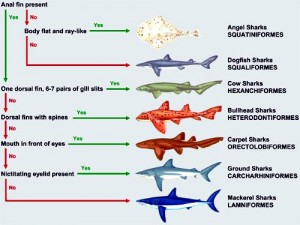“SHARKS BELONG TO A FAMILY OF FISH THAT HAVE SKELETONS MADE OF CARTILAGE, A TISSUE MORE FLEXIBLE AND LIGHTER THAN BONE. SHARK BODIES ARE ROUNDED AND TAPERING AT THE ENDS. THEY BREATHE THROUGH A SERIES OF 5 TO 7 GILL SLITS LOCATED ON EITHER SIDE OF THEIR BODIES. ALL SHARKS HAVE MULTIPLE ROWS OF TEETH AND WHILE THEY LOSE TEETH ON A REGULAR BASIS, NEW TEETH CONTINUE TO GROW IN AND REPLACE THOSE THEY LOSE THROUGHOUT THEIR LIFETIME.”
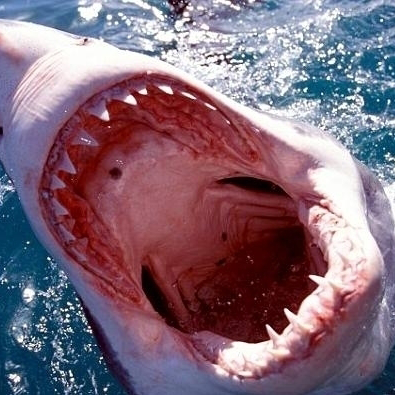
There are more than 465 known species of sharks living in our oceans today. 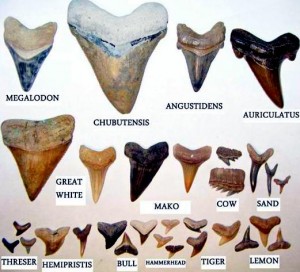 Most species of shark eat things like fish, crustaceans, mollusks, plankton, krill, marine mammals and other sharks. Sharks also have a very acute sense of smell that allows them to detect blood in the water from miles away. It is difficult to estimate population numbers since there are many different species spanning a large geographic area. However, overall shark numbers are on the decline due to the many threats they face in the wild.
Most species of shark eat things like fish, crustaceans, mollusks, plankton, krill, marine mammals and other sharks. Sharks also have a very acute sense of smell that allows them to detect blood in the water from miles away. It is difficult to estimate population numbers since there are many different species spanning a large geographic area. However, overall shark numbers are on the decline due to the many threats they face in the wild.
Sharks have 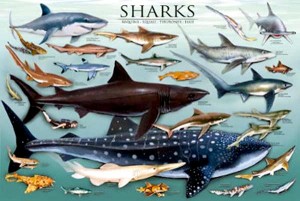 adapted to living in a wide range of aquatic habitats at various temperatures. While some species inhabit shallow, coastal regions, others live in deep waters, on the ocean floor and in the open ocean. Some species like the Bull Shark are even known to swim in salt, fresh and brackish waters.
adapted to living in a wide range of aquatic habitats at various temperatures. While some species inhabit shallow, coastal regions, others live in deep waters, on the ocean floor and in the open ocean. Some species like the Bull Shark are even known to swim in salt, fresh and brackish waters.
Sharks mature slowly and reach reproductive age anywhere from 12 to 15 years. Combined with the fact that many species only give birth to one or two pups at a time, means that sharks have great difficulty recovering after their populations have declined. Soon after birth, shark pups swim away to fend for themselves. They are born with fully fledged sets of teeth and are able to feed and live on their own.
Shark ‘skin’ is made up of a series of scales that act as an outer skeleton for easy movement and for saving energy in the water. The upper side of a shark is generally dark to blend in with the water from above and their undersides are white or lighter colored, blends in with the lighter surface of the sea from below. This helps to camouflage them from predators and prey. Sharks also have a very acute 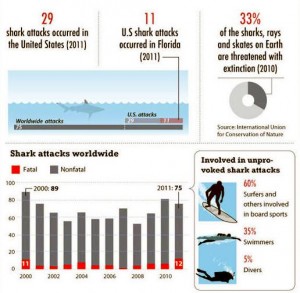 sense of smell that allows them to detect blood in the water from miles away. Shark diet depends on the species, but most species of shark eat things like fish, crustaceans, mollusks, plankton, krill, marine mammals and other sharks.
sense of smell that allows them to detect blood in the water from miles away. Shark diet depends on the species, but most species of shark eat things like fish, crustaceans, mollusks, plankton, krill, marine mammals and other sharks.
It is difficult to estimate population numbers since there are many different species spanning a large geographic area. However, overall shark numbers are on the decline due to the many threats they face in the wild. Sharks have adapted to living in a wide range of aquatic habitats at various temperatures. While some species inhabit shallow, coastal regions, others live in deep waters, ocean floors and the open ocean. Some species like the Bull Shark, have developed the ability to swim in both salt and fresh waters.
Most sharks are especially active in the evening and night when they hunt. Some sharks migrate over great distances![]() to both feed and breed. This can take them over entire ocean basins. While some shark species are solitary, others display social behavior at various levels. Hammerhead Sharks for instance, school during mating season around sea mounts and islands.
to both feed and breed. This can take them over entire ocean basins. While some shark species are solitary, others display social behavior at various levels. Hammerhead Sharks for instance, school during mating season around sea mounts and islands.
Some shark species like the Great White Shark attack and surprise their prey, usually seals and sea lions from below. Species that dwell on the ocean floor have developed the ability to bottom-feed. Others attack schooling fish in a feeding frenzy while the two largest sharks, the Whale Shark and the Basking Shark filter feed by swimming through the ocean with their mouths open wide and filtering large quantities of plankton and krill.
Various times depending on the species.
Gestation
2 months to 2 years depending on the species. Some species lay eggs, some have young covered by a thin membrane and others give birth to live young.
Number of Offspring
Depending on the species, could be 1-2 pups or more than 100 eggs or pups.
